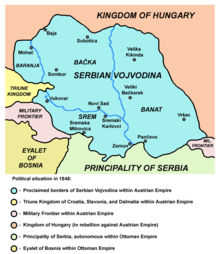Serbian Vojvodina
This article includes a list of general references, but it remains largely unverified because it lacks sufficient corresponding inline citations. (March 2012) |
| Serbian Vojvodina Српска Војводина Srpska Vojvodina | |||||||||
|---|---|---|---|---|---|---|---|---|---|
| Autonomous region (self-proclaimed) of the Austrian Empire | |||||||||
| 1848–1849 | |||||||||
 | |||||||||
| Capital | Sremski Karlovci Zemun Veliki Bečkerek Timișoara | ||||||||
| Government | |||||||||
| • Motto | "Only Unity Saves the Serbs" | ||||||||
| History | |||||||||
| 1848 | |||||||||
• Formation of Voivodeship of Serbia and Banat of Temeschwar | 1849 | ||||||||
| |||||||||

The Serbian Vojvodina (Serbian: Српска Војводина / Srpska Vojvodina) was a short-lived self-proclaimed Serb autonomous province within the Austrian Empire during the Revolutions of 1848, which existed until 1849 when it was transformed into the new (official) Austrian province named Voivodeship of Serbia and Banat of Temeschwar.
Name[]
In German, it was known as Serbische Woiwodina. In Serbian is also known as Srpsko Vojvodstvo (Serbian Cyrillic: Српско Војводство, German: Serbische Woiwodschaft; "Serbian Voivodeship"), Srpska Vojvodovina (Serbian Cyrillic: Српска Војводовина; "Serbian Vojvodovina"), and Vojvodovina Srbija (Serbian Cyrillic: Војводовина Србија; "Vojvodovina of Serbia").
History[]
During the 1848 Revolution, the Hungarians demanded independence from the Austrian Empire. However, they did not recognize the national rights of other nationalities which lived in the Habsburg Kingdom of Hungary in that time, so Serbs of Vojvodina took action to separate from the Kingdom of Hungary (which was at that time part of Habsburg Austria).
Wishing to express their national individuality and confronted with new Hungarian authorities, Serbs declared the constitution of the Serbian Vojvodina (Serbian Duchy) at the May Assembly in Sremski Karlovci (May 13–15, 1848). The Serbian Vojvodina consisted of Srem (Syrmia), Bačka (Batschka), Banat, and Baranja (Branau) regions.
The Serbs also formed a political alliance with the Kingdom of Croatia "based on freedom and perfect equality". They also recognized the Romanian nationality. The metropolitan of Sremski Karlovci, Josif Rajačić, was elected for patriarch, while Stevan Šupljikac for the first duke (voivod). A National committee was formed as the new government of Serbian Vojvodina. Instead of the old feudal regime, a new reign was founded based on the national boards with the Head Serbian National Board presiding.
By 1840 data, Serbs formed relative majority of 49.1% in Vojvodina (compared to absolute majority of 51.1% in 1828). Besides Serbs, these areas were also populated by some other ethnic groups such as Hungarians, Germans, Romanians and Croats. The new Hungarian government replied to the Serb political actions by the use of force: on June 12, 1848, a war between Serbs and Hungarians started. Austria took the side of the Kingdom of Hungary at first, while Serbs were aided by volunteers from the Principality of Serbia. A consequence of this war was the expansion of the conservative factions.
In early 1849, when the Austrian army lost battle to the Hungarian hussars, the feudal and clerical circles of Vojvodina formed an alliance with Austria. Serb troops from Vojvodina then joined the Habsburg army and helped in crushing the revolution in Hungary. With the help of Imperial Russia, the forces of reaction smothered the revolution in the summer of 1849, defeating Hungarian national movement in the Habsburg monarchy.
After the defeat of the Hungarian revolution, by a decision of the Austrian emperor, in November 1849, an Austrian crownland known as Voivodeship of Serbia and Banat of Temeschwar was formed as the successor of Serbian Vojvodina. However, Serbs were not fully satisfied with the new voivodeship, which was more ethnically mixed and included ethnic Romanian eastern parts of Banat, but excluded some areas with Serb majority.
Capitals[]
The first capital of Serbian Vojvodina was in Sremski Karlovci. It was later moved to Zemun, Veliki Bečkerek (today known as Zrenjanin), and Temišvar (Timișoara).
Flag and coat-of-arms[]
This article needs additional citations for verification. (September 2014) |
The coat-of-arms of the Serbian Vojvodina was essentially the Austrian Habsburg imperial arms, with the coat-of-arms of the Serbs (Serbian cross, with four Cyrillic letters "S", on the chests of the black eagle. The bearer of the Serbian arms was the Austrian black eagle, instead of the Serbian white one, in order to show the fidelity of the newly established Voivodship to the Imperial Court in Vienna. The coat-of-arms was simply added to the Serbian national tricolour. Thus the flag differed from the flag of the Principality of Serbia, which had a different arms in the middle of its state flag.[1]
Rulers[]
- Stevan Šupljikac, the first voivod (duke) of Serbian Vojvodina (1848).
- Josif Rajačić, administrator of Serbian Vojvodina (1848-1849).
Gallery[]

Proclamation of Serbian Vojvodina in 1848 in Sremski Karlovci

Frontlines in Vojvodina in 1848-1849

Principality of Serbia and Serbian Vojvodina in 1848.

Josif Rajačić (1785–1861), administrator of Serbian Vojvodina

An assignat with the coat of arm of Serbian Vojvodina from 1848
See also[]
References[]
- ^ "Leksiklopedija" (column), TV Novosti magazine, Belgrade, 1991.
Sources[]
- Bataković, Dušan T., ed. (2005). Histoire du peuple serbe [History of the Serbian People] (in French). Lausanne: L’Age d’Homme. ISBN 9782825119587.
- Dušan J. Popović (1990). Srbi u Vojvodini. Matica srpska. ISBN 9788636301753.
- Dušan J. Popović (1957). Srbi u Vojvodini: Od najstarijih vremena do Karlovac̆kog mira, 1699. Matica srpska.
- Lazo M. Kostić (1999). Srpska Vojvodina i njene manjine: demografsko-etnografska studija. Dobrica knjiga.
- Jovan Radonić (1956). Srpska Vojvodina od 1848-1851: (prikazano na VII skupu Odeljenja društvenih nauka 5 novembra 1955 g.).
External links[]
| Wikimedia Commons has media related to Serbian Vojvodina. |
- States and territories established in 1848
- States and territories disestablished in 1849
- Serbian Vojvodina
- 19th century in Serbia
- Vojvodina under Habsburg rule
- History of Banat
- History of Bačka
- History of Syrmia
- 1848 establishments in Europe
- 1849 disestablishments in Europe






